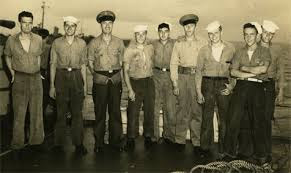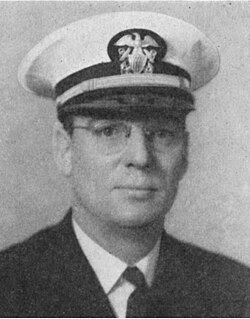
U-505 Shortly After Capture
Launched in May of 1941, the U-505 is on its 12th, and last, war patrol on 6/4/1944. Crafting a missed bag of results in its cruises through the Atlantic, before its final outing, the German pig boat will sink eight ships (worth a tonnage of 44,962 ... 3 American, 2 British, 1 Norwegian, 1 Dutch, and 1 Colombian), cause the South American country of Columbia to declare war on the Third Reich (by sinking a ship from that country), be strafed by Allied aircraft, get bombed by the RAF, earn the title of the "most heavily damaged U-boat to successfully return to port," rescue thirty-three crew members of the the torpedo boat, T-25, and have its commander at the time, Peter Zschech, undergo a nervous breakdown and blow his brains out in front of the crew during a savage depth bombing attack in 1943 (the only such occurrence of its type during the war).

Zschech
Hunter hunted, unbeknownst to the sub, using Ultra intelligence from decrypted German cipher messages, the Allies dispatch a "Hunter-Killer" group from Norfolk, Virginia, to deal with the U-505 that is commanded by Captain Daniel V. Gallery, Task Group 22.3, consisting of the escort carrier, USS Guadalcanal, and five destroyer escorts, Pillsbury, Pope, Flaherty, Chatelain, and Jenks. Searching, at 11:09 in the morning sonar contact is made and the depth charges start flying. Only 800 yards away, Chatelain, skippered by Lt. Commander J.L. Foley is the first vessel to respond to the contact (as the Guadalcanal moves away at full speed and launches an F4F Wildcat in support, joining another Wildcat and a TBF Avenger already patrolling the area), so close, that the depth charges won't have enough time to sink to the proper explosion depth. Instead, Hedgehog anti-submarine mortars are first used, then after a quick turn, a rack of depth charges. On target, a huge oil slick soon appears on the Atlantic, and less than seven minutes after the initial attack, the U-505 comes up to the surface less than 700 yards from Chatelain's position. Prey now able to be seen, the Chatelain immediately opens up on the submarine with every automatic weapon on deck, even firing a torpedo at the sub when it appears U-505 might be attacking (luckily it misses).

Hedgehog Mortars
USS Chatelain
Leaking badly, believing the ship is literally going under at any second, the U-505's commander, Oberleutnant zur See Harald Lange, orders the sub to be abandoned ... orders that the crew complies with so quickly that all the scuttling valves are not opened to the sea and the engines are left running, as the empty craft circles clockwise at about 7 knots ... a prize for the taking if a Navy team can get aboard and make repairs to the sub before it goes under for good; a risk an nine-man boarding party from Pillsbury is willing to try!
U-505 Crew
While Chatelain and Jenks take aboard survivors (only one member of the U-505's crew of 60 is killed during the day's actions, Seaman Gottfried Fischer), a boarding party of eight sailors led by 43-year-old Lt. Junior Grade Albert Leroy David comes alongside the sub and enters the vessel through the open conning tower. Inside, they secure charts and codebooks, two Enigma decoding machines, close open scuttling valves, disarm the ship's demolition charges, stop the engines, and plug as many holes as they can before setting up a tow line with Pillsbury. Low in the water and down by the stern but afloat, the first towing attempt fails when the two ships repeatedly bump into each other, so another larger party boards the craft, this time a group from the Guadalcanal that is led by the carrier's chief engineer, Commander Earl Trosino, who rigs up the sub so that the propellers turning as the craft is drug north, allows the batteries to be charged which run the internal pumps which flush the water out of U-505, successfully bringing the pig boat back to full surface trim. After three days of towing by the Guadalcanal, the sub's movements are transferred to the fleet tug, Abenaki, which brings U-505 to the Allied naval base at Port Royal Bay, Bermuda, on Monday, June 19th ... a tow journey of 1,700 nautical miles!

The Boarding Party

Barely Afloat

Salvage Operations

Towing U-505

Abenaki Takes Over
A huge catch for the United States Navy, along with the coding and cipher equipment which helps the secret decryption station at Bletchley Park, England (to make sure the secret of the U-505 being taken through the use of Ultra information, the captive submariners are segregated from other German prisoners, not allowed contact with the Red Cross, and are not returned to Germany until 1947), read German military messages for the month of June, the capture of the U-505 also gives the Allies two new G7 acoustic homing torpedoes to analyze. For his actions leading the first boarding party, David is awarded the Congressional Medal of Honor (the only such award to be given to an Atlantic Fleet sailor during WWII ... sadly, David dies of a heart attack before he can receive his medal, his place is taken at the White House ceremony in October of 1945 by his widow, Lynda Mae David), while Torpedoman's Mate Third Class Arthur W. Knispel and Radioman Second Class Stanley E. Wdowiak, the next two men to enter the sub receive the Navy Cross, and Seaman First Class Earnest James Beaver, also a member of the boarding party, gets a Silver Star for his actions. Accolades and awards, the taking of the U-505 also gets Commander Trosino the Legion of Merit, Captain Gallery is awarded the Navy Distinguished Service Medal, and Task Group 22.3 receives a Presidential Unit Citation.
Prisoners of War

David
Reunion
And what becomes of the U-505? For the duration of the war the sub is kept hidden in Bermuda as the USS Nemo while it is being intensively studied by U.S. Navy Intelligence and a host of engineering officers. War over, the sub is ticketed for conversion to scrap metal, but is saved when wheelers and dealers in Chicago (that includes Captain Gallery's brother, Father John Gallery, and a bequest from the estate of millionaire Chicago businessman, Julius Rosenwald) decide to make the vessel into a war memorial to all the sailors that lost their lives during WWII's Battle of the Atlantic (a public subscription gets $250,000 for the sub's transportation to and installation at the Chicago Museum of Science and Industry ... and German companies that built the vessel supply replacement parts for free for U-505's upgrade, wanting her to be a reminder and credit to the German technology that came close to winning the war). In 1989, the U-505 is officially designated a National Historic Landmark! Outside since its arrival in Chicago, the sub is moved into a new, covered, underground, climate controlled location and reopened to public visits in June of 2005. As part of the museum's current Explorer I package that includes entrance to the building on South Lake Shore Drive, the sub can currently be toured for $27 ($26 if you're a senior).
On the Chicago River - 1954

Museum of Science & Industry

Conning Tower

Underside

Historic Marker
6/4/1944 ... a day the United States Navy makes matter off the coast of Africa! 

No comments:
Post a Comment